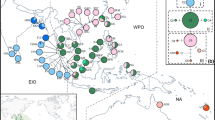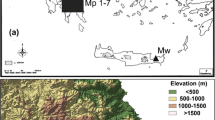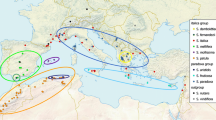Abstract
Ceriops is a viviparous mangrove with widespread species Ceriops decandra and C. tagal, and an endemic species C. australis. Genetic diversity of the three species was screened in 30 populations collected from 23 locations in the Indo West Pacific (IWP) using Inter-simple sequence repeats (ISSR) and sequences of partial nuclear gene (G3pdh) and chloroplast DNA (trnV-trnM). At the species level, the total gene diversity (Ht) revealed by ISSRs was 0.270, 0.118, and 0.089 in C. decandra, C. tagal, and C. australis, respectively. A total of six haplotypes of G3pdh and five haplotypes of trnV-trnM were recognized among the three species. Only C. decandra was detected containing more than one haplotype from each sequence data set (four G3pdh haplotypes and three trnV-trnM haplotypes). At the population level, genetic diversity of Ceriops was relatively low inferred from ISSRs (He = 0.028, 0.023, and 0.053 in C. decandra, C. tagal, and C. australis, respectively). No haplotype diversity within population was detected from any of the three species. Cluster analysis based on ISSRs identified three major geographical groups in correspond to the East Indian Ocean (EIO), South China Sea (SCS), and North Australia (NA) in both C. decandra and C. tagal. The cladogram from DNA sequences also detected the same three geographical groups in C. decandra. Analysis of molecular variance (AMOVA) revealed that most of the total variation was accounted for by differentiation between the three major geographical regions of both C. decandra and C. tagal. The significant genetic structure may result from the geological events in these regions during the recent Pleistocene glaciations. This study also provided insights into the phylogenetics of Ceriops.


Similar content being viewed by others
References
Ballment ER, Smith TJ, Stoddart JA (1988) Sibling species in the mangrove genus Ceriops (Rhizophoraceae), detected using biochemical genetics. Aust Syst Bot 1:391–397
Benzie JAH (1998) Genetic structure of marine organisms and SE Asian biogeography. In: Hall R, Holloway JD (eds) Biogeography and geological evolution of SE. Asia. Backhuys Publishers, The Netherlands, pp 197–209
Black WC IV (1995) FORTRAN programs for the analysis of RAPD-PCR markers in populations. Colorado State University, Ft. Collins, CO 80523
Chiang TY, Chiang YC, Chen YJ, Chou CH, Havanond S, Hong TN, Huang S (2001) Phylogeography of Kandelia candel in East Asiatic mangroves based on nucleotide variation of chloroplast and mitochondrial DNAs. Mol Ecol 10:2697–2710
Clarke PJ, Kerrigan RA, Westphal CJ (2001) Dispersal potential and early growth in 14 tropical mangroves: do early life history traits correlate with patterns of adult distribution? J Ecol 89:648–659
DNASTAR (1994) Lasergene. DNASTAR Inc., Madison, Wis
Dodd RS, Afzal-Rafii Z, Kashani N, Budrick J (2002) Land barriers and open oceans: effects on gene diversity and population structure in Avicennia germinans L. (Avicenniaceae). Mol Ecol 11:1327–1338
Doyle JJ, Doyle JL (1987) A rapid DNA isolation procedure for small quantities of fresh leaf tissue. Phytochem Bull 19:11–15
Duke NC (1992) Mangrove floristics and biogeography. In: Robertson AI, Alongi DM (eds) Tropical mangrove ecosystems. American Geophysical Union, Washington, DC, pp 63–100
Excoffier L (1993) Analysis of molecular variance. Version 1.55. Genetics and Biometry Laboratory, University of Geneva
Felsenstein J (1985) Evolutionary trees from DNA sequences: a maximum likelihood approach. J Mol Evol 17:368–376
Felsenstein J (1993) Phylogeny inference package (PHYLIP), Version 3.5. University of Washington, Seattle
Fitch WM (1971) Toward defining the course of evolution: minimum change for a specific tree topology. Syst Zool 20:406–416
Ge XJ (2001) Reproductive biology and conservation genetics of mangroves in south China and Hong Kong. Dissertation, University of Hong Kong
Ge XJ, Sun M (1999) Reproductive biology and genetic diversity of a cryptoviviparous mangrove Aegiceras corniculatum (Myrsinaceae) using allozyme and inter-simple sequence repeat (ISSR) analysis. Mol Ecol 8:2061–2069
Ge XJ, Sun M (2001) Population genetic structure of Ceriops tagal (Rhizophoraceae) in Thailand and China. Wetlands Ecol Manage 9:203–209
Gupta M, Chyi YS, Romero-Severson J, Owen JL (1994) Amplification of DNA markers from evolutionarily diverse genomes using single primers of simple-sequence repeats. Theor Appl Genet 89:998–1006
Hamrick JL, Godt MJW (1996) Conservation genetics of endemic plant species. In: Avise JC, Hamrick JL (eds) Conservation genetics. Chapman & Hall, New York, pp 281–304
Hamrick JL, Godt MJW, Murawski DA, Loveless MD (1991) Correlations between species and allozyme diversity: implications for conservation biology. In: Falk DA, Holsinger KE (eds) Genetics and conservation of rare plants. Oxford University Press, New York, pp 75–86
Hwang LH, Hwang SY, Lin TP (2000) Low chloroplast DNA variation and population differentiation of Chamaecypaeis formosensis and Chamaecyparis taiwanensis. Taiwan J For Sci 15:229–236
Huang SF, Hwang SH, Lin T (2002) Spatial pattern of chloroplast DNA variation of Cyclobalanopsis glauca in Taiwan and East Asia. Mol Ecol 11:2349–2358
Jian SG, Tang T, Zhong Y, Shi SH (2004)Variation in inter-simple sequence repeat (ISSR) in mangrove and non-mangrove populations of Heritiera littoralis (Sterculiaceae) from China and Australia. Aquat Bot 79:75–86
Klekowski EJJ, Lowenfeld R, Hepler PK (1994) Mangrove genetics. II. Outcrossing and lower spontaneous mutation rates in Puerto Rican Rhizophora. Int J Plant Sci 155:373–381
Liao PC, Havanond S, Huang S (2006) Phylogeography of Ceriops tagal (Rhizophoraceae) in Southeast Asia: the land barrier of the Malay Peninsula has caused population differentiation between the Indian Ocean and South China Sea. Conserv Genet 8:89–98
Lowenfeld R, Klekowski EJJ (1992) Mangrove genetics. I. Mating system and mutation rates of Rhizophora mangle in Florida and San Salvador Island. Int J Plant Sci 153:394–399
Maguire TL, Saenger P, Baverstock P, Henry R (2000) Microsatellite analysis of genetic structure in the mangrove species Avicennia marina (Forsk.) Vierh. (Aveicenniaceae). Mol Ecol 9:1853–1862
McGuinness KA (1997) Dispersal, establishment and survival of Ceriops tagal propagules in a north Australian mangrove forest. Oecologia (Berlin) 109:80–87
Nei M (1973) Analysis of gene diversity in subdivided populations. Proc Natl Acad Sci USA 70:3321–3323
Nei M (1978) Estimation of average heterozygosity and genetic distance from a small number of individuals. Genetics 89:583–590
Nice CC, Anthony N, Gelembiuk G et al (2005) The history and geography of diversification within the butterfly genus Lycaeides in North America. Mol Ecol 14:1741–1754
Olsen KM (2002) Population history of Manihot esculenta (Euphorbiaceae) inferred from nuclear DNA sequences. Mol Ecol 11:901–911
Olsen KM, Schaal BA (1999) Evidence on the origin of cassava: phylogeography of Manihot esculenta. Proc Natl Acad Sci USA 96:5586–5591
Rohlf FJ (1998) NTSYS-pc, numerical taxonomy and multivari- ate analysis system, Version 2.02a. Exeter Software. Setauket, New York
Saitou N, Nei M (1987) The neighbor-joining method: a new method for reconstructing phylogenetic trees. Mol Biol Evol 4:406–425
Schoen DJ (1982) The breeding system of Gilia achilleifolia: variation in floral characteristics and outcrossing rate. Evolution 36:596–613
Shi S, Zhong Y, Huang Y, Du Y, Qiu X, Chang H (2002) Phylogenetic relationships of the Rhizophoraceae in China based on sequences of the chloroplast gene matK and the internal transcribed spacer regions if nuclear ribosomal DNA and combined data set. Biochem Syst Ecol 30:309–319
Strand AE, Leebens-Mack J, Milligan BG (1997) Nuclear DNA-based markers for plant evolutionary biology. Mol Ecol 6:113–118
Sun M, Wong KC, Lee JSY (1998) Reproductive biology and population genetic structure of Kandelia candel (Rhizophoraceae), a viviparous mangrove species. Am J Bot 85:1631–1637
Swofford DL (1998) PAUP*. Phylogenetic analysis using parsimony and other methods, Version 4. Sinauer Associates, Sunderland, MA
Taberlet P, Gielly L, Pautou G, Bouvet J (1991) Universal primers for amplification of three non-coding regions of chloroplast DNA. Plant Mol Biol 17:1105–1109
Takayama K, Kajita T, Murata J, Tateishi Y (2006) Phylogeography and genetic structure of Hibiscus tiliaceus—speciation of a pantropical plant with sea-drifted seeds. Mol Ecol 15:2871–2881
Tan F, Huang Y, Ge X, Su G, Ni X, Shi S (2005) Population genetic structure and conservation implications of Ceriops decandra in Malay Peninsula and North Australia. Aquat Bot 81:175–188
Tang T, Zhong Y, Jian S, Shi S (2003) Genetic diversity of Hibiscus tiliaceus (Malvaceae) in China assessed suing AFLP markers. Ann Bot 92:409–414
Thompson JD, Gibson TJ, Plewniak F (1997) The Clustal X windows interface: flexible strategies for multiple sequence alignment aided by quality analysis tools. Nucleic Acids Res 25:4876–4882
Tomlinson PB (1986) The botany of mangroves. Cambridge University Press, Cambridge, pp 374–381
Voris HK (2000) Maps of Pleistocene sea levels in Southeast Asia: shorelines, river systems, and time durations. J Biogeogr 27:1153–1167
White CT (1926) A variety of Ceriops tagal C. B. Rob. (C. candolleana W. & A.). J Bot 64:220–221
Yeh FC, Yang RC, Boyle TBJ, Ye ZH, Mao JX (1997) POPGENE, the user-friendly shareware for population genetic analysis. Mol. Biol. Biotech. Center, University of Alberta, Canada
Zhong Y, Shi S, Tang X, Huang Y, Tan F, Zhang X (2000) Testing relative evolutionary rates and estimating divergence time among six genera of Rhizophoraceae using cpDNA and nrDNA sequences. Chin Sci Bull 45:1011–1015
Zietkiewicz E, Rafalski A, Labuda D (1994) Genome fingerprinting by simple sequence repeat (SSR)-anchored polymerase chain reaction amplification. Genomics 20:176–183
Acknowledgments
We thank Dr. Norman Duke, Dr. Xuejun Ge, Dr. Sonjai Havanond, and Dr. Peichun Liao for their assistance in collecting or providing some plant materials, and Mr. Miles Tracy for reading the manuscript. We also appreciate the helpful comments on this manuscript from three anonymous referees. This study was supported by grants from the National Natural Science Foundation of China (30300033, 30500049, 30230030, 30470119, U0633002), the Natural Science Foundation of Guangdong Province (500316), the Ministry of Education Special Foundation (20010558013), the Chang Hungta Science Foundation of Sun Yat-Sen University, the Qiu Shi Science and Technology Foundation and the National Key Project for Basic Research (973) grant 2003CB715904.
Author information
Authors and Affiliations
Corresponding author
Additional information
Yelin Huang and Fengxiao Tan contributed equally to this work.
Rights and permissions
About this article
Cite this article
Huang, Y., Tan, F., Su, G. et al. Population genetic structure of three tree species in the mangrove genus Ceriops (Rhizophoraceae) from the Indo West Pacific. Genetica 133, 47–56 (2008). https://doi.org/10.1007/s10709-007-9182-1
Received:
Accepted:
Published:
Issue Date:
DOI: https://doi.org/10.1007/s10709-007-9182-1




